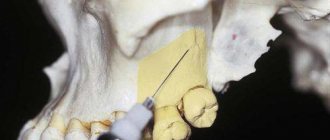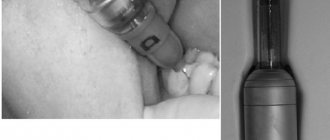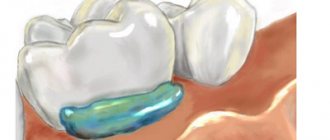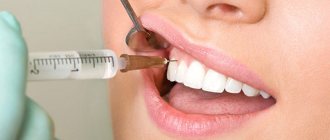When manipulating complex teeth, intraosseous anesthesia is sometimes used. This is a special type of local dental anesthesia in which an anesthetic is injected directly into the bone, which makes it possible to desensitize the entire tooth. In this case, the patient does not feel “freezing” of half of the mouth, as happens with conventional anesthesia.
Description of the procedure
There is another name - intraseptal anesthesia. The term comes from the Latin words intra - inside
, septa –
partition
. The fact is that the injection is made through the cortical plate (septum) - the outer shell of bone tissue that covers its internal structures. And since the bone cannot be pierced with a regular needle, a special syringe with a rotating bur is used.
The anesthetic solution spreads around the tooth sockets, affecting the nerve endings of the periodontal space (between the tooth root and bone tissue) and the pulp of the two closest teeth. Part of the drug enters the vessels, so periodontal tissues (gums, roots) are also anesthetized. But here it is analgesia that occurs, i.e. The gums are only deprived of pain sensitivity: the patient feels all touches and does not experience the unpleasant sensation of “freezing.”
Contraindications and side effects
Contraindications to dental anesthesia are:
- Allergic reactions to substances included in anesthetics;
- History of cardiovascular diseases;
- Diabetes;
- Pathology of the endocrine system organs;
- Some types of severe injuries of the maxillofacial area.
Side effects of anesthesia in dentistry
If the doctor is a professional in his field, complications during local anesthesia in dentistry are very unlikely. There are some things that worry patients after dental treatment and, in principle, are a variant of the norm: swelling of the lip or swelling of the cheek, pain in the gums or even a headache for several hours.
However, all these symptoms should go away within 1-3 days after treatment. If you see that the situation is not improving or even worsening, contact the dentist who performed the procedure.
Rarely, more serious complications may occur, including:
- Allergic and toxic reactions. The body's increased sensitivity to medications is due to an allergic predisposition. May manifest as urticaria, Quincke's edema, anaphylactic shock, etc.;
- Trauma to blood vessels from an injection needle, which may result in hematomas and bruises;
- Pain and burning at the injection site (quite common and considered normal);
- Lockjaw. Spasm of the masticatory muscles. Occurs when muscle fibers or nerves are damaged;
- Loss of sensation. Occurs when a nerve is damaged during injection;
- Damage to soft tissues. If sensitivity is lost, the patient may bite his tongue, lip, or cheek;
- Infection. If antiseptic rules are not followed.
Advice for patients
Pain during anesthetic injection and treatment will depend on several factors:
- from your sensitivity;
- professionalism of the dentist and equipment of the clinic;
- on the degree of tooth destruction and the depth of caries.
https://www.youtube.com/watch?v=https:accounts.google.comServiceLogin
If you are planning a visit to the doctor, we advise you to observe a number of points:
- do not drink alcohol the day before, this may worsen the effect of the anesthetic;
- if you have a cold, cough, or runny nose, it is better to postpone your visit until you have fully recovered;
- Women and girls are not recommended to visit the dentist during menstruation, because... during this period, blood clotting worsens (by the way, do not be surprised if the anesthesiologist asks you this question before surgery; operations are not performed during menstruation.
- choose your clinic carefully! Now their choice is very large, but very few comply with important requirements and all antiseptic requirements!
The anesthesia procedure is recommended when performing the following manipulations:
- Treatment of deep caries.
- The process of depulping, that is, performing extirpation or amputation of the pulp.
- Teeth extraction procedure.
- Other surgery.
- Preparation for dental prosthetics.
- Various types of orthodontic therapy.
We invite you to familiarize yourself with Pulpitis. Etiology. Pathogenesis. Classification. — CyberPedia
It should be noted that moderate caries is also an indication for anesthesia, since the boundaries of the enamel and dentinal layers are very sensitive, so pain in this situation is noted quite often.
Before performing an anesthesia procedure, the dentist must find out whether the patient has serious somatic diseases or allergic reactions to medications. Thus, the main contraindications to the use of painkillers may be:
- The occurrence of allergies after the administration of an anesthetic.
- The presence of diabetes mellitus and a history of acute heart disease, for example, heart attacks or strokes six months ago.
- A number of other hormonal disorders against the background of diseases of the endocrine system, for example, thyrotoxicosis and so on.
It is important to note that against the background of decompensated forms of endocrine diseases, treatment of the patient should be carried out only in a hospital. Particular caution is recommended when performing anesthesia on children and pregnant women.
Indications and contraindications
Intraosseous anesthesia is used when conventional infiltration anesthesia is not enough, i.e. when the solution does not get into the right space, and because of this the patient feels pain during dental procedures. This can happen in the following clinical cases:
- removal of unerupted or incorrectly positioned teeth;
- removal of wisdom teeth;
- treatment of caries complications;
- dental restoration;
- periodontal operations.
Wisdom tooth removal
Sometimes intraosseous anesthesia is used in pediatric dentistry to reduce the feeling of numbness in the mouth and tongue in children.
By the way! Intraseptal anesthesia is mainly used on the lower teeth, because it is technically more difficult to anesthetize areas of the upper jaw in this way.
A specific contraindication to the use of this type of anesthesia is purulent inflammation of the bone tissue of the teeth. The remaining contraindications are the same as for any type of dental anesthesia:
- allergy to the drug;
- acute diseases of the heart and blood vessels;
- any disease from the acute stage with an increase in body temperature;
- unstable mental state of the patient;
- age up to 3 years;
- 1st and 3rd trimesters of pregnancy.
Scope of intraosseous anesthesia
A common area of application of intraosseous anesthesia is tooth extraction, and this method is most often used for the extraction of lower molars.
This situation is explained by the specifics of the type of anesthesia itself. Intraosseous anesthesia gives a strong, but, unfortunately, short-lived effect - no more than 40 minutes.
For this reason, it is not suitable for long and complex operations, but is excellent for tooth extraction.
The fact that this type of anesthesia is more often used on lower molars is due to the fact that it is easier to drill and administer anesthetic in the lower jaw. Strictly speaking, almost all dental operations on the lower jaw are performed easier and faster than on the upper jaw, so this feature hardly applies to intraosseous anesthesia as such.
At the same time, intraosseous anesthesia is practically indispensable during operations to remove impacted (unerupted) and dystopic (improperly located in the gum tissue) teeth, the removal of which is a rather complex procedure.
All operations in the alveolar region are performed using intraosseous anesthesia. It is also widely used in dental operations in children - due to its speed, efficiency and minimum discomfort. Improvements in technology have made it possible to expand the scope of application of this type of anesthesia, and today it is used for dental restoration and installation of veneers.
A breakthrough in intraosseous anesthesia technology was made in 2006 with the presentation of the universal computer-based injector QuickSleeper. The injector is suitable for all types of injection anesthesia, but it showed particularly outstanding results during testing of intraosseous methods of pain relief.
For this device, special needles with a shifted center of gravity and a cutting edge were specially developed for faster and easier penetration into tissues, including bone. The use of QuickSleeper has significantly expanded the possibilities of using intraosseous anesthesia.
Execution technique
In terms of implementation, this is a relatively simple type of local anesthesia. The doctor does not require any special skills to administer intraosseous anesthesia. But he needs certain equipment in the form of a burr syringe with a rotating nozzle, because a regular needle “will not take” the thickness of the cortical plate and will simply break.
Pre-anesthesia
It turns out that the bone is first drilled, and then an anesthetic enters its cavity. To prevent the patient from feeling pain, conventional infiltration anesthesia is first performed. The injection is made into soft tissues. After this, wait a couple of minutes until pain relief occurs. And only then intraosseous anesthesia is given.
Injection into bone tissue
The doctor inserts a special syringe between two teeth, one of which is subject to further treatment or removal. Rotating, the needle pierces the cortical plate, passes the basal and alveolar bones and goes deeper into the bone tissue. The goal is to reach the nerve trunk that supplies nerves to the roots of the teeth.
The anesthetic is released and fills the space inside the bone. Pain relief occurs fairly quickly, but the patient does not experience any numbness, because everything happens too deep. In rare cases, a person may feel bloating, but it quickly passes. And if intraseptal anesthesia is carried out using modern computer technologies (STA system), in which the program automatically evaluates tissue resistance, then there is no sensation at all.
Nuances
There are several nuances of intraosseous local anesthesia that the doctor should take into account.
- The diameter of the bur must match the diameter of the needle to prevent leakage of the drug.
- It is easier for young patients to undergo intraosseous anesthesia, because their bone tissue is more pliable and soft. With older patients, insertion of the needle may be difficult.
- When immersing the needle into the bone tissue, an effort should be felt. If it is not there, then the syringe does not go where it is needed.
- If it is necessary to manipulate the pulp, additional anesthesia is required, because the anesthetic in it quickly dissolves.
- Anesthesia lasts only 30-40 minutes, so you should not hesitate with manipulations.
To be on the safe side, the dentist can always first send the patient for an x-ray to make sure the image shows the correct location of the cortical plate or to see some other anatomical features on it.
By the way! Intraosseous anesthesia in modern dentistry can be carried out not in 2, but in 3 stages, when before infiltration anesthesia an application is also performed (the gums are lubricated with a surface anesthetic). This allows you to relieve the patient from a second of pain when inserting a needle.
Drugs
For intraosseous anesthesia, standard dental anesthetics are used: ultracaine, bupivacaine, mepivacaine, septanest, etc. The doctor determines the need to use drugs with an adrenaline component in each individual case, depending on the clinical case and the patient’s medical history.
The volume of anesthetic solution for intraosseous anesthesia is required to be small: no more than 0.4 ml, because there are no “escape routes” for the medicine in the bone. The analgesic effect develops within 1 minute, so you can begin dental procedures almost immediately.
Painless dental treatment
Relatively recently, a number of therapeutic actions that are associated with unpleasant sensations for a person could be carried out without a preliminary anesthesia procedure, so, of course, it is not surprising that many people are very afraid of visiting dentists.
When a person postpones an appointment with the dentist until the last minute, having a common carious lesion, he risks waiting for more serious complications of his disease to arise, which will subsequently force him to seek surgical treatment. Today, in absolutely all clinics, as well as dental offices, doctors carry out dental treatment without pain, for which purpose they use various types of anesthesia in dentistry.
https://www.youtube.com/watch?v=ytpolicyandsafetyen-GB
This is a decrease or complete elimination of sensitivity in the patient’s entire body or in its individual parts. In most situations, this can be achieved through the introduction of medications that help disrupt the transmission of pain impulses to the brain from the site of the intervention.
What types of anesthesia in dentistry exist?
Until recently, treatment and tooth extraction procedures were accompanied by painful sensations, but today dentistry has every opportunity to ensure that the patient does not feel the slightest discomfort even during complex interventions. Anesthesia in dentistry is designed to ensure that any procedure is painless.
Anesthesia is a decrease in the sensitivity of a certain area of tissue to pain. Various methods can achieve complete loss of sensitivity for a certain period of time. It is widely used for most manipulations in therapeutic and surgical dentistry, for implantation and prosthetics, and even for routine teeth cleaning.
Regardless of the types of anesthesia in dentistry, they are used for the following indications:
- the need for superficial anesthesia before the main injection,
- treatment of dental diseases - caries of any degree, pulpitis, periodontitis and many others,
- therapy of gum and periodontal tissue diseases,
- removal of teeth and their roots,
- dental implantation, i.e. installation of a large number of artificial metal roots,
- performing surgical operations,
- treatment of acute purulent inflammation of the bone tissue of the jaws,
- neuritis, neuralgia of the facial nerve.
In addition, pain relief is indicated even for minor interventions, for example, during ultrasonic teeth cleaning, when the patient has increased sensitivity or nervousness.
There are three types of anesthesia: local, general and sedation. Local involves anesthetizing a specific area of tissue for comfortable procedures, while the patient remains conscious. General anesthesia or anesthesia is performed using analgesics that are introduced into the body by inhalation or intravenously, during which the patient is unconscious. During sedation, gas is administered by inhalation; this type involves remaining conscious.
Modern local anesthesia is called carpule - the composition is supplied in disposable containers (carpules or ampoules), where the necessary components are already mixed in the required dosage. The doctor inserts the capsule into a special syringe - compared to disposable syringes, its needle is thinner, so the process of administering the drug is less painful.
The applique machine is widely used when performing simple operations that do not take much time. The drug is applied with a cotton swab or fingers to the desired area, permeates the soft tissues, as a result of which their sensitivity is reduced. It penetrates to a depth of no more than 3 mm. Action time is from 10 to 25 minutes. Very often it precedes another type of pain relief.
Infiltration is provided by an injection that is injected around its non-medical name - “freezing”. It is more often used in the treatment of teeth in the upper jaw, since the alveolar process has a more porous structure, which means pain relief will be more effective. The action time is about 60 minutes, enough to perform quite complex manipulations - endodontic treatment, pulp removal, therapy of deep caries.
Conduction anesthesia in dentistry is aimed at blocking the nerve that transmits the pain signal. This allows you to “disable” not only one tooth, but also a certain area of the jaw that is connected to this nerve. Most often, this type is used when it is necessary to cure or remove several teeth located nearby, especially in the lower jaw.
Intraligmentary is also called intraperiodontal. The specificity of this type is to apply more pressure during the insertion process. This allows the product to be evenly distributed in the periodontal space and penetrate into the intraosseous space. Begins to act immediately – after 15-45 seconds. Action time is from 20 minutes to half an hour.
https://www.youtube.com/watch?v=ytcreatorsen-GB
Indications – impossibility or ineffectiveness of other types. As a rule, it is used in the treatment and removal of lower molars and operations on the alveolar process. Its implementation involves dissecting the mucous membrane, creating a hole in the bone using a bur, after which a needle is inserted into the hole and the drug is supplied to the spongy substance under high pressure. The advantage of this type is its effectiveness even with small volumes of a weak product. Action time – from 60 minutes.
Stem involves blocking the branches of the trigeminal nerve at the base of the skull. This is advisable when performing extensive surgical interventions in maxillofacial surgery. The effect of this type of anesthesia covers both jaws.
Modern anesthesia in dentistry is carried out using ready-made anesthetic compounds. The most common are drugs based on articaine - this is the main active ingredient of many anesthetics. They are 1.5-2 times more effective than lidocaine, and 6 times more effective than novocaine. A big advantage is that such drugs are very safe today.
"Ultracaine"
The result of developments by French pharmaceuticals. This drug based on articaine is available in three versions, differing in the concentration of the component and the presence/absence of a vasoconstrictor component:
- "Ultracaine DS forte" - epinephrine concentration 1:100,000,
- "Ultracaine DS" - epinephrine concentration 1:200,000, can be used during pregnancy, breastfeeding, and the presence of cardiovascular diseases,
- "Ultracaine D" - without epinephrine, can be used in patients prone to allergic reactions, since it does not contain preservatives necessary to stabilize drugs with a vasoconstrictor component.
"Ubistezin"
A German-made anesthetic, the composition is similar to Ultracaine, or more precisely, to its two forms containing epinephrine.
"Scandonest" is an anesthetic produced in France, the main component of which is mepivacaine 3%. It contains no vasoconstrictor components or preservatives. This explains its popularity when performing dental procedures in patients at risk. "Mepivastezin" is a hollow analogue of "Scandonest", but already made in Germany (3M).
We invite you to familiarize yourself with Preferential dental prosthetics in Moscow
"Septanest"
Available in two forms:
- articaine epinephrine 1:100.000,
- articaine epinephrine 1:200.000.
The difference between this drug and others is the relatively larger number of preservatives in the composition, which increases the likelihood of developing allergic reactions.
"Novocaine"
“Novocaine” in combination with a vasoconstrictor component is much weaker than articaine drugs. In addition, its effectiveness decreases if it is necessary to anesthetize the area of inflamed tissue. “Novocaine” has a vasodilating effect, and therefore is very “dependent” on vasoconstrictors. It is difficult to call such a manipulation safe, especially if it is necessary to anesthetize an area of the oral cavity for a patient at risk, a pregnant or lactating patient, or a child.
Complications are quite rare, but it is impossible to completely eliminate them from practice. They are divided into two groups:
- local: damage to soft tissues by a needle, breakage of a needle, infection of tissues with poorly disinfected instruments, damage to a vessel (resulting in hematoma), tissue necrosis, paresis of the facial nerve, contracture of the temporomandibular joint,
- general: allergic reactions, toxic reactions, changes in blood pressure, dizziness.
Anesthesia is performed only by an anesthesiologist. According to the method of drug delivery, it is divided into inhalation (drugs "Prichlorethylene", "Sevoran") and intravenous ("Gexenal", "Propanidid", "Propofol", "Ketamine", etc.). The drugs put you to sleep and the patient does not feel pain. How long a specific anesthesia lasts is determined by the doctor, taking into account how much time the dentist will need.
Anesthesia requires certain indications:
- pronounced dental phobia and mental disorders,
- pronounced gag reflex,
- complex surgical interventions,
- a large number of teeth subject to extraction or complex treatment,
- ineffective use of local anesthetics.
Such anesthesia in pediatric dentistry is completely justified if a child needs to have a lot of baby teeth treated - it is very difficult to “force” children to be in the doctor’s chair, especially for a long period of time.
Contraindications to anesthesia are as follows:
- relative – exacerbation of chronic diseases, viral infections, pregnancy and lactation, respiratory infections, etc.,
- absolute – heart and kidney failure, some types of heart defects, decompensated diabetes mellitus and other severe endocrine diseases, respiratory dysfunction.
Possible consequences and complications
Intraosseous anesthesia has many advantages. In addition to the fact that it does not cause a feeling of numbness, allows for a small volume of anesthetic and provides high-quality anesthesia, the possibility of local tissue infection is minimal. But there are still risks.
Most of the negative consequences are associated with improper technique of intraosseous anesthesia or non-compliance with the rules of asepsis and antisepsis. The result of this is suppuration and inflammation, which, if left untreated, can spread to the entire jaw. If the doctor missed and did not inject the solution into the bone tissue, then the patient may experience numbness in part of the mouth and tongue.
It’s worse if the needle gets into a large vessel. This is fraught with internal bleeding and hematoma formation. And, of course, all this will be very painful, because preliminary infiltration anesthesia does not always cope with the consequences of non-compliance with the technique of conducting the main type of anesthesia. To minimize complications, the patient must follow the doctor’s recommendations, because too active behavior in the dental chair can also lead to the development of unpleasant consequences.
Types of anesthesia in dentistry
Toothache is an ailment that almost every person experiences during his life. Such painful sensations are a sign of the presence of one or another disease of the dental organs. Such pathologies require not only therapeutic, but in many situations, surgical intervention. It often happens that patients postpone their visit to the dentist due to fear of pain during dental treatment.
Let's look at the most famous types of anesthesia in dentistry.
Toothache is a problem that almost every person has encountered. It is a sign of one or another pathology of the organs of the dental system. Such diseases require therapeutic and, in many cases, surgical treatment. Patients often put off visiting the dentist for fear of pain during dental treatment.
Relatively recently, a number of therapeutic procedures associated with unpleasant sensations for the patient could be carried out without prior anesthesia, so it is not surprising that many people are afraid of the dentist's office. By postponing a meeting with a specialist “until the last minute,” a patient with ordinary carious lesions risks waiting for the development of complications of the disease, which may require surgical treatment.
Currently, in all clinics and dental offices, doctors perform dental treatment without pain, for which various types of anesthesia are used.
Anesthesia is understood as a decrease or complete disappearance of sensitivity in the entire body or in certain areas of it. In most cases, this is achieved through the administration of medications that disrupt the transmission of pain impulses to the brain from the area of intervention. Anesthesia in dentistry is necessary to ensure that the patient does not experience pain during dental treatment.
https://www.youtube.com/watch?v=ytpressen-GB
Pain relief is indicated during the following manipulations:
- treatment of deep caries;
- extirpation or amputation of the pulp (depulpation);
- tooth extraction (removal);
- other surgical interventions;
- preparing teeth for prosthetics;
- some types of orthodontic treatment.
Please note: medium caries can also be an indication for anesthesia, since the area of the border of the enamel and dentin layers is quite sensitive, and pain during dental treatment in this case is noted quite often.
Fears associated with pain during treatment and tooth extraction are due to the fact that previously there were no high-quality anesthetic drugs. But today, almost all dental clinics use new generation local anesthetics. Modern drugs make it possible to completely eliminate pain not only during the main operation, but even at the time of their administration.
Anesthesia is the absolute disappearance or partial decrease in sensitivity in the entire body or its individual parts. This effect is achieved by introducing special drugs into the patient’s body that block the transmission of pain impulses from the area of intervention to the brain.
Based on the principle of impact on the psyche, there are two main types of anesthesia:
- Local anesthesia, in which the patient is awake, and loss of sensitivity occurs exclusively in the area of future medical procedures.
- General anesthesia (anesthesia). The patient is unconscious during the operation, the whole body is anesthetized and the skeletal muscles are relaxed.
Depending on the method of delivering the anesthetic to the body, dentistry distinguishes between injection and non-injection anesthesia. With the injection method, the anesthetic drug is administered through an injection. It can be injected intravenously, into the soft tissues of the oral cavity, into the bone or periosteum. In non-injection anesthesia, the anesthetic is administered by inhalation or applied to the surface of the mucosa.
General anesthesia is the complete loss of sensitivity of nerve fibers, accompanied by impaired consciousness. In dentistry, anesthesia for dental treatment is used less frequently than local anesthesia. This is due not only to the small area of the surgical field, but also to the large number of contraindications and possible complications.
General anesthesia in dentistry is only necessary for long-term complex maxillofacial operations - correction of cleft palate, multiple implantations, surgery after injury. Other indications for the use of general anesthesia:
- allergic reactions to local anesthetics;
- mental illnesses;
- panic fear of manipulation in the oral cavity.
We invite you to familiarize yourself with Ceramic braces – fashionable and cool!
Contraindications:
- diseases of the respiratory system;
- pathologies of the cardiovascular system;
- intolerance to anesthetic drugs.
The anesthetic can be delivered by injection or inhalation. The drug most commonly used by dentists for inhalational general anesthesia is nitrous oxide, known as laughing gas. Using an intravenous injection, the patient is immersed in a medicated sleep; for this purpose, drugs are used that have a sleeping pill, analgesic, muscle relaxant and sedative effect. The most common are:
- Ketamine.
- Propanidid.
- Hexenal.
- Sodium hydroxybutyrate.
In dental treatment, local anesthesia is most in demand, aimed at blocking nerve impulses from the surgical field. Local anesthetics have an analgesic effect, due to which the patient does not experience pain, but retains sensitivity to touch and temperature.
Local anesthesia is used for the following procedures:
- removal of cystic formations;
- turning for a bridge or crown;
- pin tooth extension;
- implantation;
- channel cleaning;
- surgical treatment of gums;
- removal of carious tissues;
- tooth extraction;
- excision of the hood over the wisdom tooth.
Depending on what area and for how long the sensitivity needs to be deprived, the dentist selects the optimal technology, medicine and its concentration. The main methods of administering anesthetic are:
- infiltration;
- intraligamentary;
- stem;
- intraosseous;
- applique.
Used in dental practice and maxillofacial surgery. The advantage of the method is its rapid action, long-lasting analgesic effect, the possibility of repeated administration during a protracted operation, rapid removal of the anesthetic from the body, and deep analgesia of a large area of tissue. About eighty percent of dental interventions are performed under infiltration anesthesia.
The method is used for the following manipulations:
- removal and treatment of teeth (mainly the upper jaw row);
- opening and removal of purulent formations under the skin;
- removing a foreign body from the gums;
- treatment of complicated caries;
- suturing;
- tumor extraction;
- performing hernia repair.
The anesthetic medicine is injected in layers, first under the mucous membrane at the apex of the tooth root, and then into the deeper layers. The patient feels discomfort only with the first injection; the rest are completely painless.
https://www.youtube.com/watch?v=ytabouten-GB
It is a modern type of infiltration anesthesia. The dose of the administered anesthetic is minimal (does not exceed 0.06 ml), which makes it possible to treat and remove teeth in pregnant and lactating women.
The anesthetic is injected into the periodontal space using a special syringe and under high pressure. The number of injections depends on the number of roots of the tooth. Sensitivity to pain disappears instantly without causing a feeling of numbness, so the patient can speak freely and does not experience discomfort after the operation.
Restrictions on the use of the method are:
- The duration of the manipulation is more than 30 minutes.
- Fang manipulations. Due to their anatomical features, it is not always possible to anesthetize them intraligamentously.
- Inflammatory processes in the periodontium, periodontal pocket, gumboil.
- Root cyst of the tooth.
The intraligamentous anesthesia method is the most painless and safe in dentistry, therefore it is often used in pediatric practice. Ease of implementation, painlessness, safety and high efficiency make the method popular among dentists. The cost of this procedure is higher than the infiltration procedure due to the high prices of injectors.
Distinctive features of the stem method of pain relief are the power and long duration of the effect. It is used during long-term surgical operations and in situations where it is necessary to block sensitivity in the tissue area of the entire lower or upper jaw.
Indications for conduction anesthesia are:
- high intensity pain syndrome;
- neuralgia;
- removal of cystic formations;
- endodontic treatment;
- severe injuries to the jaw and zygomatic bone;
- curettage;
- complex tooth extraction.
The injection is injected into the area of the base of the skull, thanks to which two jaw nerves can be blocked at once - both the upper and the lower. The injection is performed by an anesthesiologist and exclusively in a hospital.
Unlike all other methods of local anesthesia, stem anesthesia does not act on nerve endings, but completely on a nerve or group of nerves. The anesthetic effect time is one and a half to two hours. Novocaine and Lidocaine are considered the basic drugs; in modern anesthesiology, more effective agents are used.











